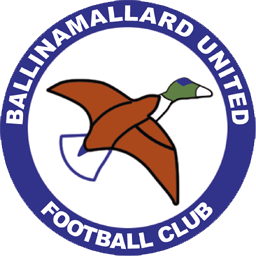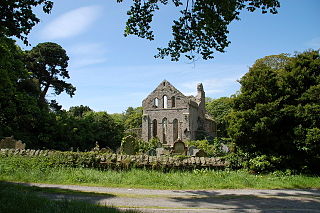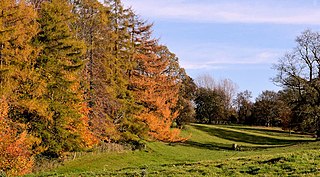
County Fermanagh is one of the thirty-two counties of Ireland, one of the nine counties of Ulster and one of six counties of Northern Ireland.

Dromore is a town, townland and civil parish in County Tyrone, Northern Ireland. It is nine miles (14 km) south west of Omagh on the A32 and sixteen miles (26 km) from Enniskillen. The population of Dromore was 1,198 at the 2011 Census.
A townland is a small geographical division of land, historically and currently used in Ireland and in the Western Isles in Scotland, typically covering 100–500 acres (40–202 ha). The townland system is of Gaelic origin, antedating the Norman invasion, and most have names of Irish origin. However, some townland names and boundaries come from Norman manors, plantation divisions, or later creations of the Ordnance Survey. The total number of inhabited townlands in Ireland was 60,679 in 1911. The total number recognised by the Irish Place Names database as of 2014 was 61,098, including uninhabited townlands, mainly small islands.

Ballinamallard United Football Club is a semi-professional Northern Irish football club playing in the NIFL Championship. The club, re-formed in 1975 after being dormant since the 1960s, hails from Ballinamallard, near Enniskillen, County Fermanagh, and plays its home matches at Ferney Park. Club colours are all royal blue (home), and all white (away).

Carrickmore is a small town in County Tyrone, Northern Ireland. It is situated in the historic barony of Omagh East, the civil parish of Termonmaguirk and the Roman Catholic Parish of Termonmaguirc between Cookstown, Dungannon and Omagh. It had a population of 612 in the 2001 Census. In the 2011 Census 2,330 people lived in the Termon Ward, which covers the Carrickmore and Creggan areas.

Ballinamallard or Bellanamallard is a small village and townland in County Fermanagh, Northern Ireland. It had a population of 1,364 people in the 2021 Census. It lies to the north of Enniskillen and is within Fermanagh and Omagh district.

Greyabbey or Grey Abbey is a small village, townland and civil parish located on the eastern shores of Strangford Lough, on the Ards Peninsula in County Down, Northern Ireland.

Ardstraw is a small village, townland and civil parish in County Tyrone, Northern Ireland, three miles northwest of Newtownstewart. In the 2001 Census it had a population of 222 people.

Cill Ghallagáin is a small Gaeltacht coastal townland and village in the northwest corner of Kilcommon Parish, County Mayo, Republic of Ireland, an area of 345 hectares in size. Off the northern coast of this townland lies Kid Island, an island of 13 hectares rising on steep cliffs to a height of 95 metres (311 ft) above sea level. The island is used for grazing sheep in the summer months. Kilcommon Parish consists of two peninsulas – Dún Chaocháin and Dún Chiortáin, to the west.

Naul, is a village, townland, and civil parish at the northern edge of the traditional County Dublin in Ireland. The Delvin River to the north of the village marks the county boundary with County Meath. Naul civil parish is in the historic barony of Balrothery West.

Ballynahatty is a townland in County Down, Northern Ireland. It lies on the southern edge of Belfast. It contains the Giants Ring, a henge monument.
Ferney Park is a football stadium in Ballinamallard, County Fermanagh, Northern Ireland. It is the home stadium of Ballinamallard United. It was first used by Ballinamallard United in 1975, when the club was founded.

Tirkennedy is a barony in County Fermanagh, Northern Ireland. To its west lies Lower Lough Erne and south Upper Lough Erne, and it is bordered by seven other baronies: Clanawley and Magheraboy to the west; Lurg and Omagh East to the north; Clogher to the east; Magherastephana and Knockninny to the south.

Magheracross is a townland and civil parish in County Fermanagh, Northern Ireland. It extends in area from just north of Enniskillen to the border with County Tyrone and includes a small enclave in County Tyrone. The main town in the parish is Ballinamallard.

Kilcorney is a civil parish in County Clare, Ireland. It lies in the Burren region of the northwest of the county.

Coa is a townland and hamlet in Magheracross civil parish, County Fermanagh, Northern Ireland. It is located east of the town of Ballinamallard and is 399.11 acres in area. Landmarks include St Marys Church Coa, Cavanalough Glebe, and Killee Lough.

Drummurry is a townland in Magheracross civil parish, County Fermanagh, Northern Ireland. The topography is undulating and slightly marshy. Land use is predominantly agricultural but includes newer urban development on the outskirts of Ballinamallard township.

Sidaire is a townland in Magheracross civil parish, County Fermanagh, Northern Ireland. It is located in the barony of Tirkennedy, in civil parish of Magheracross.

Relagh is a locality and townland in County Fermanagh, Northern Ireland. Relagh is located at 54° 23' 29" N, 7° 34' 50" W and is 3km north of Enniskillen and southeast of Ballinamallard. It is in the Magheracross Civil Parish.



















